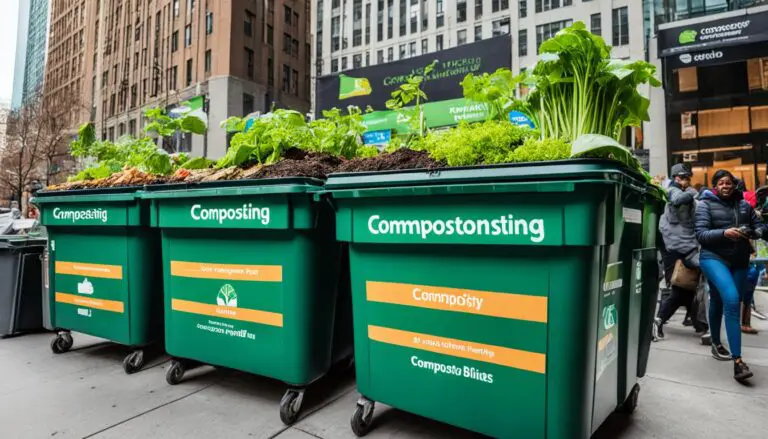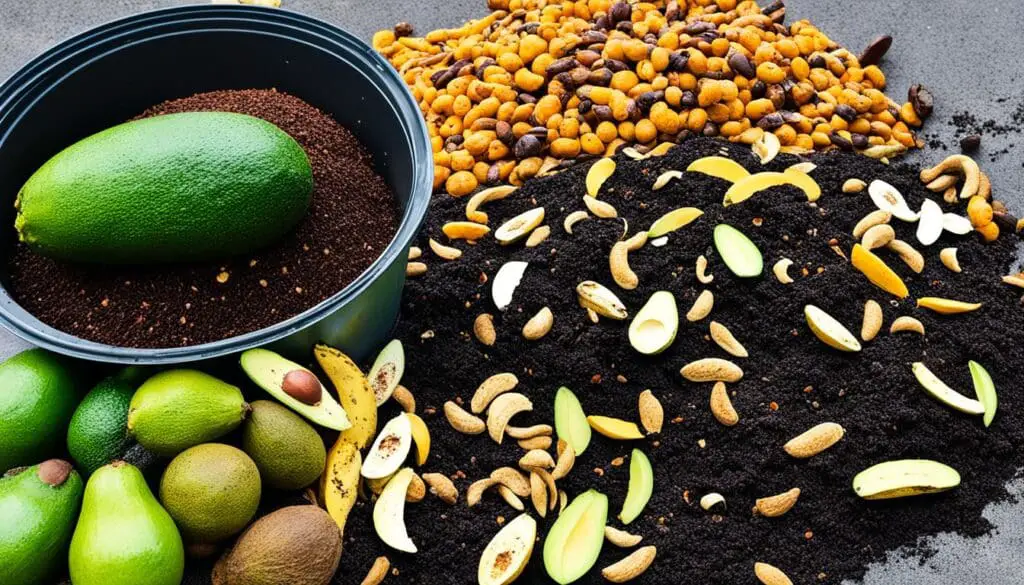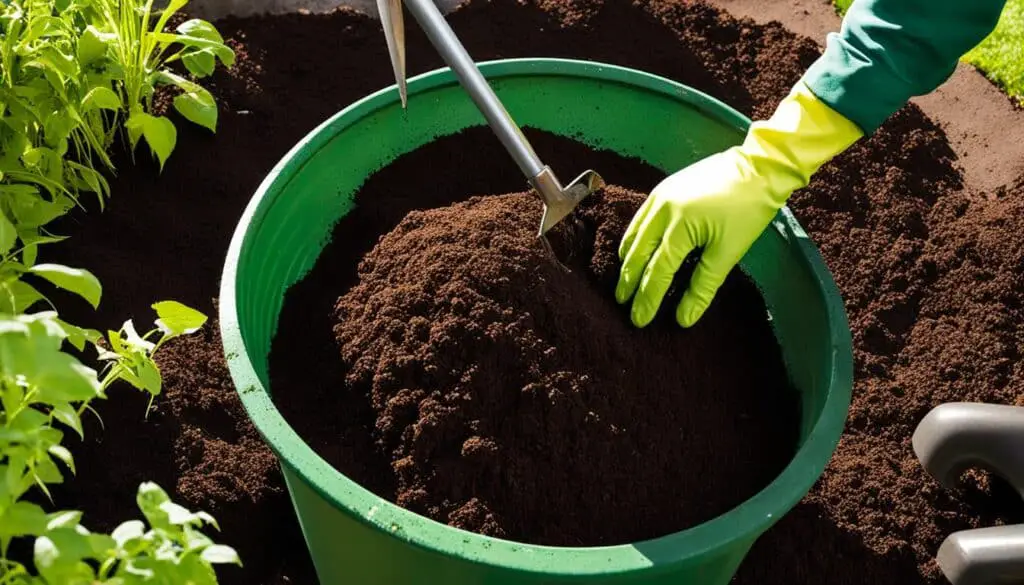My name is Jane, and I’m here to provide you with a comprehensive guide on composting in urban areas. In today’s world, waste management and sustainability are critical concerns, especially in urban environments. Composting offers a practical and eco-friendly solution for reducing our carbon footprint and creating a more sustainable future.
Composting in urban areas involves converting organic waste, such as food scraps and yard waste, into nutrient-rich compost that can be used to enrich soil and support plant growth. By composting at home, we can divert a significant amount of waste from ending up in landfills.
In this guide, we will explore the benefits of urban composting, how to get started, what materials can be composted in urban areas, maintenance tips, and how to use the compost once it’s ready. Whether you live in a small apartment or a house with limited outdoor space, there are composting methods and techniques that can fit your needs.
Let’s dive into the world of urban composting and discover how we can make a positive impact on our environment and create healthier, more sustainable communities.
Key Takeaways:
- Composting in urban areas is an essential practice for sustainable waste management.
- It helps reduce the amount of organic waste sent to landfills and minimizes greenhouse gas emissions.
- Composting enriches the soil, improves water-holding capacity, and supports sustainable food production.
- To get started, you’ll need a compost bin or container, composting tools, and a suitable composting method.
- Fruit and vegetable scraps, coffee grounds, yard waste, and shredded paper are ideal materials for urban composting.
Benefits of Composting in Urban Areas
Composting in urban areas offers numerous benefits. Firstly, it helps reduce the amount of organic waste sent to landfills, thereby minimizing greenhouse gas emissions. Additionally, composting enriches the soil and improves its water-holding capacity, which is particularly important in urban environments where green spaces are limited. Moreover, it allows city dwellers to actively participate in the circular economy and contribute to sustainable food production.
By diverting organic waste from landfills, urban composting plays a crucial role in waste reduction and environmental preservation. Organic materials that end up in landfills produce harmful gases, such as methane, a potent greenhouse gas that contributes to climate change. Composting instead allows these materials to break down naturally, releasing less harmful gases and reducing greenhouse gas emissions.
Furthermore, composting in urban areas can have a significant positive impact on soil health. In densely populated cities, green spaces are often limited, and the soil quality may be degraded due to construction and pollution. Compost acts as a natural fertilizer, providing essential nutrients to the soil and improving its structure. This leads to healthier and more fertile soil, which is essential for urban gardening, rooftop gardens, or community green spaces.
Urban composting not only benefits the individual and their immediate surroundings but also contributes to the larger goal of sustainable food production. By composting organic waste and turning it into nutrient-rich compost, city dwellers can reduce their reliance on synthetic fertilizers and contribute to healthier, more sustainable agriculture. This closed-loop system allows for a more efficient use of resources and minimizes waste in the food production cycle.
In summary, composting in urban areas offers a range of benefits, including waste reduction, greenhouse gas emission reduction, soil enrichment, and contributing to sustainable food production. By embracing urban composting, individuals can play an active role in creating a more environmentally friendly and sustainable future.
Getting Started with Urban Composting
To begin urban composting, you will need a few essential tools and materials. These include a compost bin or container, a composting thermometer, and a pitchfork for turning the compost. It’s important to select the right composting equipment to ensure efficient decomposition and maintain a healthy compost pile.
If you prefer a ready-made solution, there are various compost bins available for purchase. These bins are specifically designed for urban environments, offering compact sizes and odor control features. Alternatively, you can opt for a DIY approach by repurposing containers such as old barrels or wooden crates.
Here is an example of a list of composting equipment you may need to get started:
- Compost bin or container
- Composting thermometer
- Pitchfork or compost turning tool
After you have chosen your composting equipment, it’s time to decide on the composting method that suits your needs. There are different composting methods available, each with its own advantages and considerations. The two most common methods for urban composting are aerobic composting and vermicomposting.
Aerobic composting involves the use of oxygen to break down organic materials. This method requires regular turning or mixing of the compost pile to ensure proper aeration. It is suitable for larger outdoor spaces or community composting initiatives where space is available.
Vermicomposting, on the other hand, relies on the help of worms to accelerate the composting process. This method is well-suited for compact urban environments as it can be done indoors using a worm bin. Worms, such as red wigglers, help to break down the organic waste into nutrient-rich vermicompost.
Table: Pros and Cons of Different Composting Methods
| Aerobic Composting | Vermicomposting |
|---|---|
| Large outdoor space required | Suitable for compact urban environments |
| Requires regular turning or mixing | Low maintenance, no turning required |
| Longer composting process | Faster composting with the help of worms |
| Optimal for larger amounts of organic waste | Well-suited for smaller quantities of organic waste |
Once you have your composting equipment and chosen a composting method, it’s important to find a suitable location for your compost bin. The location should receive adequate sunlight and be easily accessible for regular maintenance. Consider placing the compost bin in a convenient spot in your backyard or on a balcony if you have limited space.
Remember, starting urban composting is a sustainable and rewarding practice that helps reduce waste and supports a healthier environment.
What to Compost in Urban Areas
In urban areas, composting provides an effective solution for managing organic waste sustainably. By composting at home, you can play a crucial role in reducing landfill waste and contributing to a greener environment. To ensure successful urban composting, it’s important to understand which materials are compostable and suitable for your compost bin.
Here are some common compostable materials that are ideal for urban composting:
- Fruit and vegetable scraps: Including peels, cores, and trimmings. These provide valuable nutrients for your compost.
- Coffee grounds: Rich in nitrogen and help to balance the carbon-to-nitrogen ratio in your compost.
- Eggshells: Crushed eggshells add calcium to the compost, promoting healthy plant growth.
- Yard waste: Grass clippings, leaves, and small branches can be composted, but avoid weeds or diseased plants.
- Shredded paper: Newspaper, cardboard, and office paper can be added in moderation to provide carbon and aid in moisture retention.
It’s important to remember that certain materials should be avoided in urban composting to prevent issues such as pests or unpleasant odors. Do not compost dairy products, meat, or oily/greasy food waste, as these can attract rodents and slow down the composting process.
Composting in urban areas offers a sustainable solution for managing organic waste, and by knowing what to compost, you can create nutrient-rich compost for your plants.
To maintain a healthy balance in your compost, aim for equal parts of green (nitrogen-rich) and brown (carbon-rich) materials. This ensures a diverse mix that aids in decomposition and creates nutrient-rich compost for your plants.
To visualize the compostable materials suitable for urban composting, refer to the table below:
| Green Materials (Nitrogen-rich) | Brown Materials (Carbon-rich) |
|---|---|
| Fruit and vegetable scraps | Shredded paper |
| Coffee grounds | Cardboard |
| Eggshells | Newspaper |
| Grass clippings | Leaves |
By composting the right materials, you can create a nutrient-rich soil amendment to nourish your plants and contribute to a sustainable urban ecosystem.
Maintaining Your Urban Compost
Proper maintenance is crucial for successful urban composting. To ensure optimal decomposition and a healthy compost pile, follow these essential maintenance practices:
- Turning the compost: Regularly turning the compost helps provide oxygen to the microorganisms and accelerates decomposition. Use a pitchfork or shovel to carefully mix the compost pile, ensuring that all organic materials are evenly incorporated.
- Monitoring moisture levels: Maintaining the right moisture content is essential for effective composting. Aim for a damp sponge-like consistency. If the compost is too dry, add water to moisten it. If it’s too wet, add dry leaves or shredded newspaper to absorb excess moisture.
- Troubleshooting common issues: Occasionally, you may encounter challenges such as foul odors or pest infestations in your compost. To address these issues:
| Problem | Solution |
|---|---|
| Foul odors | Adjust the carbon-nitrogen ratio by adding more brown materials (carbon-rich) or turning the compost more frequently to improve aeration. |
| Pest infestations | Ensure you’re not adding meat, dairy, or oily food waste to the compost, as these can attract pests. Cover the compost with a layer of straw or leaves to discourage pests, and consider using a compost bin with a tight-fitting lid. |
By following these maintenance practices, you can ensure a healthy and productive compost pile in your urban environment.
Testimonial:
“Properly maintaining my urban compost has been the key to successful composting. Regularly turning the pile and monitoring the moisture levels have helped me create nutrient-rich compost for my urban garden.” – Jane, urban composting enthusiast
Harvesting and Using Your Compost
Once the composting process is complete, usually after a few months to a year, it’s time to harvest your nutrient-rich compost. The compost should have a dark, crumbly texture and emit a pleasant earthy smell, indicating that it is ready to be used in various gardening applications.
To ensure optimal plant growth and overall soil health, there are several ways you can use your compost:
1. Enrich Garden Soil
One of the main benefits of compost is its ability to improve soil fertility. Mix the compost into your garden soil to enhance its nutrient content and promote healthy plant growth. The organic matter in the compost helps retain moisture, maintain soil structure, and provide essential nutrients for plants. Spread a layer of compost over the topsoil, and gently work it into the existing soil using a garden fork or tiller.
2. Boost Container Gardening
Compost can also be mixed with potting soil to create a nutrient-rich growing medium for container gardening. Whether you’re growing flowers, herbs, or vegetables in pots or containers, adding compost to the potting mix can significantly improve plant health and yield. Mix one part compost with three parts potting soil for an ideal blend.
3. Enhance Landscaping Projects
Another way to utilize your compost is by incorporating it into landscaping projects. Whether you’re establishing new flower beds, laying sod, or planting trees and shrubs, spread a layer of compost on the soil surface before planting. This will help improve water infiltration, soil structure, and overall plant vitality.
| Potential Uses for Compost | Benefits |
|---|---|
| Enriching garden soil | Improves nutrient content, water retention, and soil structure |
| Boosting container gardening | Enhances potting mix fertility, leading to healthier plants |
| Enhancing landscaping projects | Improves water infiltration, soil structure, and plant vitality |
By incorporating your compost into these gardening practices, you can take full advantage of its organic matter, which acts as a slow-release fertilizer and soil conditioner. Not only will your plants thrive, but you’ll also contribute to the sustainability of organic gardening and reduce the need for synthetic fertilizers.
Remember, compost is a valuable resource, so use it wisely and share any excess with friends or neighbors who are also passionate about organic gardening and sustainable practices.
Composting Challenges in Urban Areas
Composting in urban areas can present unique challenges due to space constraints and the need for effective odor control methods. As city dwellers, we may have limited outdoor space or live in apartments, making it necessary to find suitable composting solutions. Additionally, managing odor can be a concern, especially if our composting bins are located near living areas or shared spaces.
Space Constraints
One of the main challenges of composting in urban areas is the limited available space. Unlike rural or suburban environments, we may not have large yards or gardens to accommodate traditional compost piles. However, there are alternative options that can work within our space constraints:
- Smaller compost bins: Opt for compact compost bins or tumblers that can fit on balconies, patios, or even kitchen countertops. These smaller systems are designed to compost efficiently while taking up less space.
- Vermicomposting: Also known as worm composting, vermicomposting involves using special composting worms to break down organic waste. Vermicomposting systems, such as worm bins, are compact and can be easily maintained indoors, making them ideal for urban composting.
By choosing the appropriate composting method based on available space, we can overcome the challenge of limited outdoor areas in urban settings.
Odor Control
An essential aspect of successful urban composting is effectively managing odor. Since urban compost bins are often located in close proximity to living spaces or shared areas, minimizing odor is crucial to maintaining a pleasant environment. Here are some tips for odor control:
- Balance carbon and nitrogen: Ensure a proper balance of green (nitrogen-rich) and brown (carbon-rich) materials in your compost. Excess nitrogen-rich materials can contribute to unpleasant odors. A ratio of approximately 3 parts brown materials to 1 part green materials is usually effective.
- Avoid odor-causing items: Certain items, such as meat, dairy products, and oily/greasy waste, can lead to strong odors and attract pests. It’s advisable to exclude these materials from your urban compost to prevent unpleasant smells.
- Maintain regular turning: Regularly turning the compost helps aerate it, promoting decomposition and reducing odors. Aim to turn the compost at least once a week, ensuring that all materials are adequately mixed.
By following these odor control measures, we can compost effectively while minimizing any potential smell-related issues.
Local Regulations and Community Guidelines
When engaging in urban composting, it’s essential to be mindful of local regulations and community guidelines in your area. Different cities and neighborhoods may have specific rules regarding composting, including bin placement, acceptable materials, and frequency of collection.
“Composting in urban areas requires compliance with local regulations and community guidelines. By familiarizing ourselves with these rules, we can ensure responsible and lawful composting practices.”
| Challenge | Solution |
|---|---|
| Space constraints | Use smaller compost bins or opt for vermicomposting systems |
| Odor control | Maintain a balance of materials, avoid odor-causing items, and regularly turn the compost |
| Local regulations | Follow guidelines and regulations set by your local authorities and community |
The challenges of urban composting can be overcome with careful planning and adherence to best practices. By utilizing compact composting systems, effectively managing odor, and following local regulations, we can successfully incorporate composting into our urban lifestyles and contribute to a more sustainable future.
Conclusion
Composting in urban areas is a practical and eco-friendly solution for managing organic waste. By following this comprehensive guide, you can seamlessly integrate composting into your urban lifestyle and contribute to sustainable waste management. Not only will you reduce your environmental impact, but you will also play a vital role in the health and sustainability of your community.
Urban composting offers numerous benefits, including the reduction of organic waste sent to landfills, minimizing greenhouse gas emissions, and enriching the soil for better water retention and plant growth. By composting at home, you actively participate in the circular economy and promote sustainable food production.
Make a difference today by starting composting in your urban area. Through this simple and environmentally-friendly practice, you can be part of the solution for a greener future. Reduce waste, nourish the soil, and contribute to a more sustainable and resilient community. Embrace urban composting and join the movement towards a healthier planet.
FAQ
Why is composting important in urban areas?
Composting in urban areas is important for sustainable waste management and reducing greenhouse gas emissions. It also enriches the soil and contributes to the circular economy.
What tools and materials are needed to start urban composting?
To start urban composting, you will need a compost bin or container, composting thermometer, and a pitchfork for turning the compost.
What composting methods can be used in urban areas?
Depending on the space available and personal preference, urban composting can be done using aerobic or vermicomposting methods.
What can be added to a compost bin in urban areas?
Compostable materials in urban areas include fruit and vegetable scraps, coffee grounds, eggshells, yard waste, shredded paper, and cardboard.
How should I maintain my urban compost?
Proper maintenance includes regular turning of the compost, monitoring moisture levels, and troubleshooting issues such as odors or pests.
When is compost ready to be harvested?
Compost is usually ready to be harvested after a few months to a year. It should have a dark, crumbly texture and a pleasant earthy smell.
What challenges can arise when composting in urban areas?
Challenges in urban composting may include limited space, odor control, and adherence to local regulations and community guidelines.
Why should I start composting in urban areas?
Urban composting is a practical and eco-friendly way to manage organic waste, reduce environmental impact, and contribute to a greener future.



